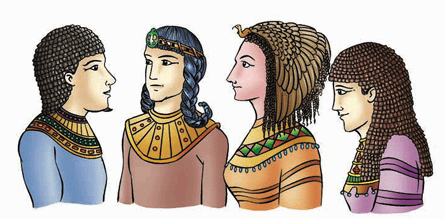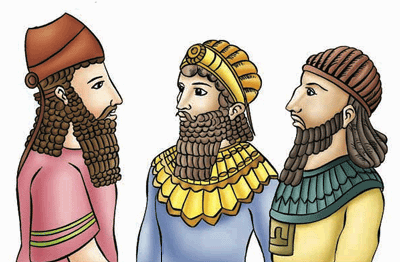Hair and Beard Styles from the 14th century to the 7th century B.C.
(Samples of ancient beard and male and female hair styles)
Egyptian wigs for men and women became the style; especially, for those in the upper societies; about 1400 B.C.
No one seems to know why wigs were so popular among the Egyptians; however, there is speculation that there might have been a combination of the religious custom of shaving the head and the practical problem of keeping the hair clean and free of vermin in the hot Egyptian climate. There is also evidence that they had a taste for elaborate hair styles which could not be combed out frequently.

Although it appears that shaving the head was practically universal among men; except when they were away from their own country, women sometimes wore wigs over their own hair, which was parted in the middle and combed flat, often showing below the wig in the front.
When making the wigs, which were usually large and well ventilated, there was no attempt to imitate natural hair. They were very decorative, often indicating social ranking, and they served the same function as any head covering in protecting the user from the sun.
When the common people started to copy the same styles, the people of rank then adopted longer and more elaborate wigs. There were several periods in history during which high-ranking women wore exceedingly large wigs.
The best wigs were made of human hair; however, various substitutes; such as, wool and palm-leaf fibers were also utilized. Natural dark brown hair was sometimes worn, but the wigs were frequently dyed with black being the favorite color.
Examples of Asyrian and Persian beard and hair styles from the eighth and seventh centuries B.C.
The Assyrian styles were similar to the Egyptian styles in that wigs and false beards were worn by the upper classes. The wigs were not as voluminous as the larger Egyptian ones; and the shapes were different.
The crimped hair, real or false, was usually parted in the center, pulled back behind the ears, and allowed to hang down to the shoulders. The ends were often tightly curled which was also similar for women.

Beards were more indicative of rank than wigs; and kings and high officials wore them long and elaborately curled. Slaves, on the other hand, shaved off their beards; and soldiers either shaved or wore short beards.
Both hair and beards were given great care; treated with perfumed ointments, curled with tongs, dyed black or henna, and, for special occasions, powdered with gold dust.
Links to other hair-related units: alopec-; barba-; Beards; capillaro-; chaeto-; cirro-; coife; crino-; hirsute; pilo-; pogo-; tricho-; villi-.
